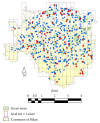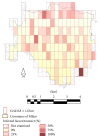Canine fecal contamination in a metropolitan area (Milan, north-western Italy): prevalence of intestinal parasites and evaluation of health risks
- PMID: 25478583
- PMCID: PMC4248419
- DOI: 10.1155/2014/132361
Canine fecal contamination in a metropolitan area (Milan, north-western Italy): prevalence of intestinal parasites and evaluation of health risks
Abstract
Intestinal parasites of dogs represent a serious threat to human health due to their zoonotic potential. Thus, metropolitan areas presenting high concentrations of pets and urban fecal contamination on public areas are at sanitary risk. Major aim of this survey was to determine prevalence of zoonotic parasites in dog fecal samples collected from public soil of Milan (north-western Italy). Differences in parasites prevalence distribution were explored by a geographical information system- (GIS-) based approach, and risk factors (human density, sizes of green parks, and dog areas) were considered. The metropolitan area was divided into 157 rectangular subareas and sampling was performed following a 1-kilometer straight transect. A total of 463 fecal samples were analyzed using centrifugation-flotation technique and ELISA to detect Giardia and Cryptosporidium coproantigens. A widespread fecal contamination of soil was highlighted, being fecal samples found in 86.8% of the subareas considered. The overall prevalence of intestinal parasites was 16.63%. Zoonotic parasites were found, such as Trichuris vulpis (3.67%), Toxocara canis (1.72%), Strongyloides stercoralis (0.86%), Ancylostomatidae (0.43%), and Dipylidium caninum (0.43%). Giardia duodenalis was the most prevalent zoonotic protozoa (11.06%), followed by Cryptosporidium (1.10%). Faeces from subareas characterized by broad green areas showed to be particularly prone to infection.
Figures


References
-
- Acha P. N., Szyfres B. Zoonoses et maladies transmissibles communes à l'homme et aux animaux. Paris, France: Office International des Epizooties; 1989.
MeSH terms
LinkOut - more resources
Full Text Sources
Other Literature Sources
Medical

